Master of the Banderoles
Playing Cards by the Master of the Banderoles, one of the earliest professional printmakers.
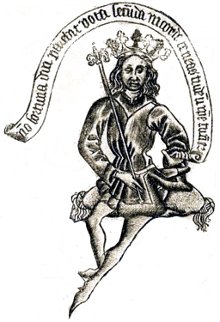
Playing Cards by the “Master of the Banderoles”
Der Meister mit den Bandrollen
The Master of the Banderoles - so-called because of the banderoles (speech banners) present in many of his prints - originated in the North Netherlands during the mid-fifteenth century and lived in the east of the Netherlands between Zwolle and Bocholt ca. 1462-1500. He (or she) was one of the earliest professional printmakers. Most of his output consisted of devotional and decorative images for the emerging market for prints which would have been pasted onto boards or into books. He tended to copy subjects from other sources whilst building up a composition, or reuse his own motifs, rather than create original works.
Right: detail from 'Fortune and Death' by the Master of the Banderoles, c.1450-1475
showing a banderole or scroll containing 'speech' emanating from a King →
Working almost within living memory of the first arrival of playing cards into Europe, the Master of the Banderoles’ set of playing cards provide a rare glimpse into their early development. Some of the Master's work was based on Italian models, so it is possible that he was influenced by or had visited Italy. These eight cards appear to be from an Italian (or Spanish)-suited pack of at least 48 cards, although no Aces or court cards are present in the fragment. The cards have been engraved in sequential order and are separated by a single line.
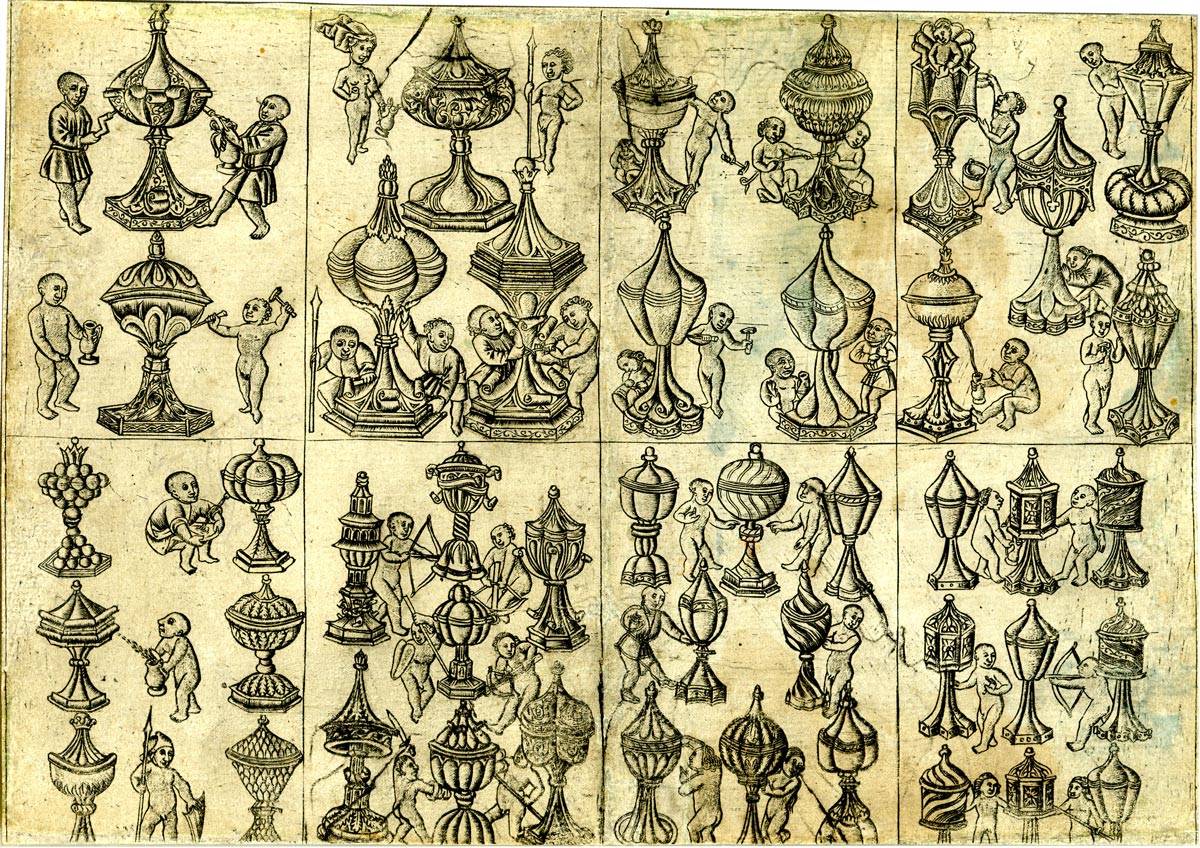
Above: an uncut sheet of eight playing cards probably the work of the Master of the Banderoles, an artist who is supposed to have worked on the Lower Rhine about 1470. The designs suggest Italian inspiration. Height of sheet: 192 millimetres; Width: 270 millimetres. ©The Trustees of the British Museum. All rights reserved.
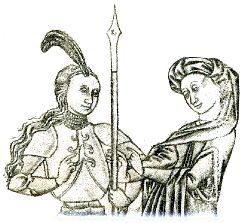
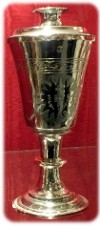
The Master of the Banderoles produced religious and devotional images as well as subjects such as grotesque alphabets and these playing cards. He worked in the new medium of engraving which required draughtsmanship and technical ability for copying the works of existing masters. The cross-over between religious and profane images is evident in the cup suit symbols which are in fact ciboria, cups for holding hosts from the Christian Eucharist and presumably ‘sacred’, similar to the chalices used for wine. The Master of the Banderoles seems to be very familiar with their designs. They were usually made of precious metal, or plated with silver, and possibly decorated with engraving. Ciboria were sometimes kept at homes to be handy for the Last Rites where needed. The impish little figures - ‘putti’ - cavorting amongst the ciboria add a slightly irreverent sense of fun and playfulness to the playing cards, consistent with their use as a recreational game.
Cherubs and ‘Putti’, which started reappearing in medieval art during the 15th century, were distinct. Cherubs were Angels and thus close to God. Putti were associated with Eros/Cupid and profane love and used as decorative art on buildings, frontispieces and illuminated capital letters. The Master of the Banderoles entertainingly merges spiritual and secular themes in his pack of playing cards by placing ‘putti’ amongst the ciboria.
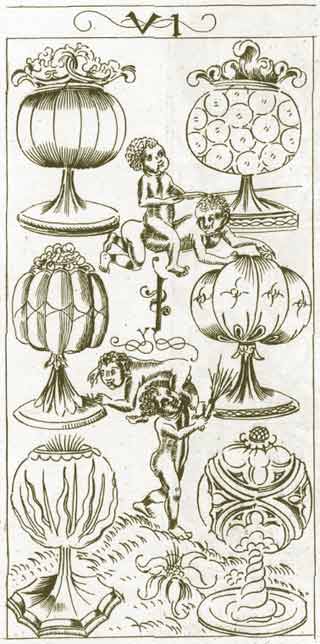
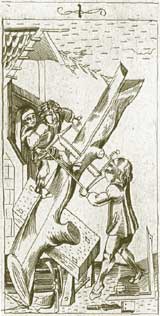
Similar antics can be seen in the miniature figures adorning the numeral cards in another elaborate Italian or Spanish-suited, Gothic pack of playing cards, produced in South Germany, which appears to commemorate the marriage, in 1496, of Felipe I of Spain and Doña Juana, daughter of Ferdinand and Isabella more →
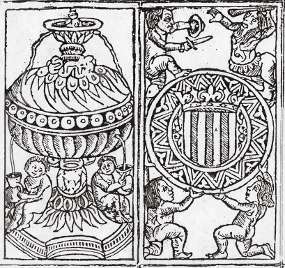
Right: Ace of Batons and Six of Cups from the pack of cards by the South German Engraver showing children cavorting amongst the pip symbols, late 15th century.
Left: Aces of Cups & Coins from a Gothic Spanish-suited pack produced in Spain, late 15th / early 16th century decorated with small children playing around the suit symbols.
← In addition, there is another Gothic Spanish-suited pack with naked children gamboling in the numeral cards, produced by woodcuts rather than engraving, believed to have been made in Spain around the same time.
The practice of decorating playing cards with small naked figures, or ‘putti’, persisted for several centuries in many Spanish and Italian-suited cards. In the Baroque period the putto came to represent the omnipresence of God. see example →
Bibliography and References:
Lockhart, Anne I.: Four Engravings by the Master with the Banderoles, The Bulletin of the Cleveland Museum of Art, Vol. 60, No. 8 (Oct., 1973), pp. 247-254
Acknowledgements: thanks to Samten de Wet for kind assistance with research.
I would suggest an Italian origin for these ideas - which permeated through Venice to Augsburg, Nuremberg, and the so-called Northern German Renaissance - which had as its climatic fruition, the work of Durer. Warburg scholars have paid attention to this field, and even for example, Durer made versions of the so-called Tarot of Mantegna. The classical research for this imaginal world can be traced back to Cyriacus of Ancona. These are a few bones of thought . . . Samten

Above: detail of gothic woodcarving in walnut wood on the choir stalls in Plasencia cathedral, Spain. Nudity could represent the purity and innocence associated with childhood. In the playing cards it might allude to the unpredictability of fortune in the game.

By Simon Wintle
Member since February 01, 1996
I am the founder of The World of Playing Cards (est. 1996), a website dedicated to the history, artistry and cultural significance of playing cards and tarot. Over the years I have researched various areas of the subject, acquired and traded collections and contributed as a committee member of the IPCS and graphics editor of The Playing-Card journal. Having lived in Chile, England, Wales, and now Spain, these experiences have shaped my work and passion for playing cards. Amongst my achievements is producing a limited-edition replica of a 17th-century English pack using woodblocks and stencils—a labour of love. Today, the World of Playing Cards is a global collaborative project, with my son Adam serving as the technical driving force behind its development. His innovative efforts have helped shape the site into the thriving hub it is today. You are warmly invited to become a contributor and share your enthusiasm.
Related Articles

Pierre Varangot
Tracing the origins, legality and legacy of Pierre Varangot’s San Sebastián deck.

French Revolutionary cards by Pinaut
Seven cards from a French Revolutionary pack by Pinaut featuring characters from classical antiquity...

An Anonymous Belgian Transformation Pack
Anonymous Belgian transformation pack borrowing many images from earlier designs by Braun & Schneide...

Tarot de las Coscojas
Historical playing card design, tarot symbolism and an almost psychedelic medieval surrealism.

Songs with Flute accompaniment
Eighteenth century English engraved cards with music for voice and flute.

Barok
Dutch pack from the 1950s with colourful Baroque courts, reprinted in 1983.

Trappola cards from Poland
Trappola cards published in Warsaw by J G Du Port during the 18th century.

Verkeers Kwartet
A helpful quartet game celebrating the 75th anniversary of road safety exams making traffic safer.

Dr Sacheverell
Dr. Henry Sacheverell's impeachment in 1710 sparked widespread public unrest and political upheaval,...

Laurenzo Propagine
Spanish-suited cards made in Italy by Laurenzo Propagine.

Les Jeux de Pastor
Striking designs by Edouard Pastor focusing on the heads of figures from the medieval period.

Le Jeu des Personnages de l’Antiquité et du Moyen-Age
Edouard Pastor’s designs in black and gold inspired by Antiquity and the Middle Ages.

Rouen Pattern - Portrait Rouennais
An attractive XV century French-suited design from Rouen became the standard English & Anglo-America...

Archaic Spanish proof sheets
2 x uncoloured proof sheets of archaic Spanish-suited playing cards produced for “New Spain”, possib...

Johann Nejedly Tarok Cards
Johann Nejedly, a 19th-century Viennese card maker, produced Tarock cards featuring modern scenes th...

Grunwald 1410 – The Battle of Tannenberg
Details from the famous painting of the Battle of Grunwald (1410) by the Polish painter Jan Matejko....
Most Popular
Our top articles from the past 28 days

